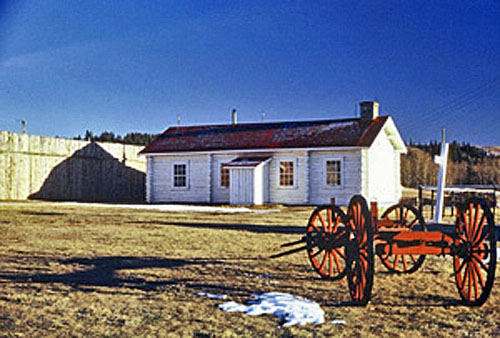Other Name(s)
Fort Walsh National Historic Site of Canada
Fort Walsh
Fort Walsh
Links and documents
Construction Date(s)
1875/01/01 to 1880/01/01
Listed on the Canadian Register:
2007/06/12
 Statement of Significance
Statement of Significance
Description of Historic Place
Fort Walsh National Historic Site of Canada is the site of an early North West Mounted Police post set among the rolling Cypress Hills in southern Saskatchewan. In the mid-twentieth century, the Royal Canadian Mounted Police constructed 10 log buildings on the site for its remount ranch. The siting and architecture of these buildings was intended to evoke the original nineteenth-century fort. The national historic site designation refers to the site and the archaeological remnants of the original Fort Walsh.
Heritage Value
Fort Walsh was declared a national historic site in 1926 because:
- the fort served from 1878-1882 as the headquarters of the North West Mounted Police;
- the fort played a key role in imposing Canadian law from 1875-1883, in implementing Canada’s Indian policy, and in supervising the Lakota who fled to Canada under Tantanka Iyotanka (Sitting Bull) after the Battle of Little Big Horn.
The heritage value of Fort Walsh National Historic Site lies in the historical associations as illustrated by the setting and archaeological evidence of North West Mounted Police presence and activities during the 1875-1883 period. Fort Walsh was constructed in 1875-80 under commander James Morrow Walsh using local resources, NWMP and Métis labour, was abandoned in 1883, scavenged for parts to build new posts nearby, and then burned in 1886. In the mid-twentieth century, the RCMP built a remount station on the site for breeding and raising horses and symbolizing the force’s bond to its history. Parks Canada now operates the post as a historic site open to the public.
Sources: Historic Sites and Monuments Board of Canada, Minutes, June 1992; Commemorative Integrity Statement.
Character-Defining Elements
Key features contributing to the heritage value of this site include:
- the setting of the fort high on a hill amidst rolling hills with diverse natural vegetation (fescue grassland, shrubs and woodland) and wildlife (moose, deer and elk);
- the footprint and location of the original palisade as indicated by remains;
- archaeological remnants of 46 nineteenth-century buildings and structures inside the original palisade with their composition, materials, technology, function distribution and locations;
- all archaeological remains of 1875-1883 NWMP life, including those that define the original structures, other works, and trails including some 100,000 artifacts which have been removed from the site and placed in storage at Parks Canada;
- viewscapes to on-site remnants of fur trade life outside the palisade (some 20 have been identified), to the vestiges of historic trails, to the locations of former First Nations and Metis sites, to the townsite of Fort Walsh, to the hospital, to the site of Farwell and Solomon trading posts, to the remains of ranch sites, towards the location of the Cypress Hills Massacre.
 Recognition
Recognition
Jurisdiction
Federal
Recognition Authority
Government of Canada
Recognition Statute
Historic Sites and Monuments Act
Recognition Type
National Historic Site of Canada
Recognition Date
1924/06/04
 Historical Information
Historical Information
Significant Date(s)
1875/01/01 to 1883/01/01
Theme - Category and Type
- Governing Canada
- Security and Law
Function - Category and Type
Current
Historic
- Defence
- Military Defence Installation
Architect / Designer
n/a
Builder
n/a
 Additional Information
Additional Information
Location of Supporting Documentation
National Historic Sites Directorate, Documentation Centre, 5th Floor, Room 89, 25 Eddy Street, Gatineau, Quebec
Cross-Reference to Collection
Fed/Prov/Terr Identifier
749
Status
Published
Related Places

Commissioners Residence
The Commissioner’s Residence is located at the Fort Walsh National Historic Site. The simple, single-storey, log structure has a central entrance flanked by double-hung sash…

Stable, Building 6
The Stable, Building 6 is located at Fort Walsh National Historic Site of Canada. The log structure has a long, rectangular design, small regularly placed, high windows along the…